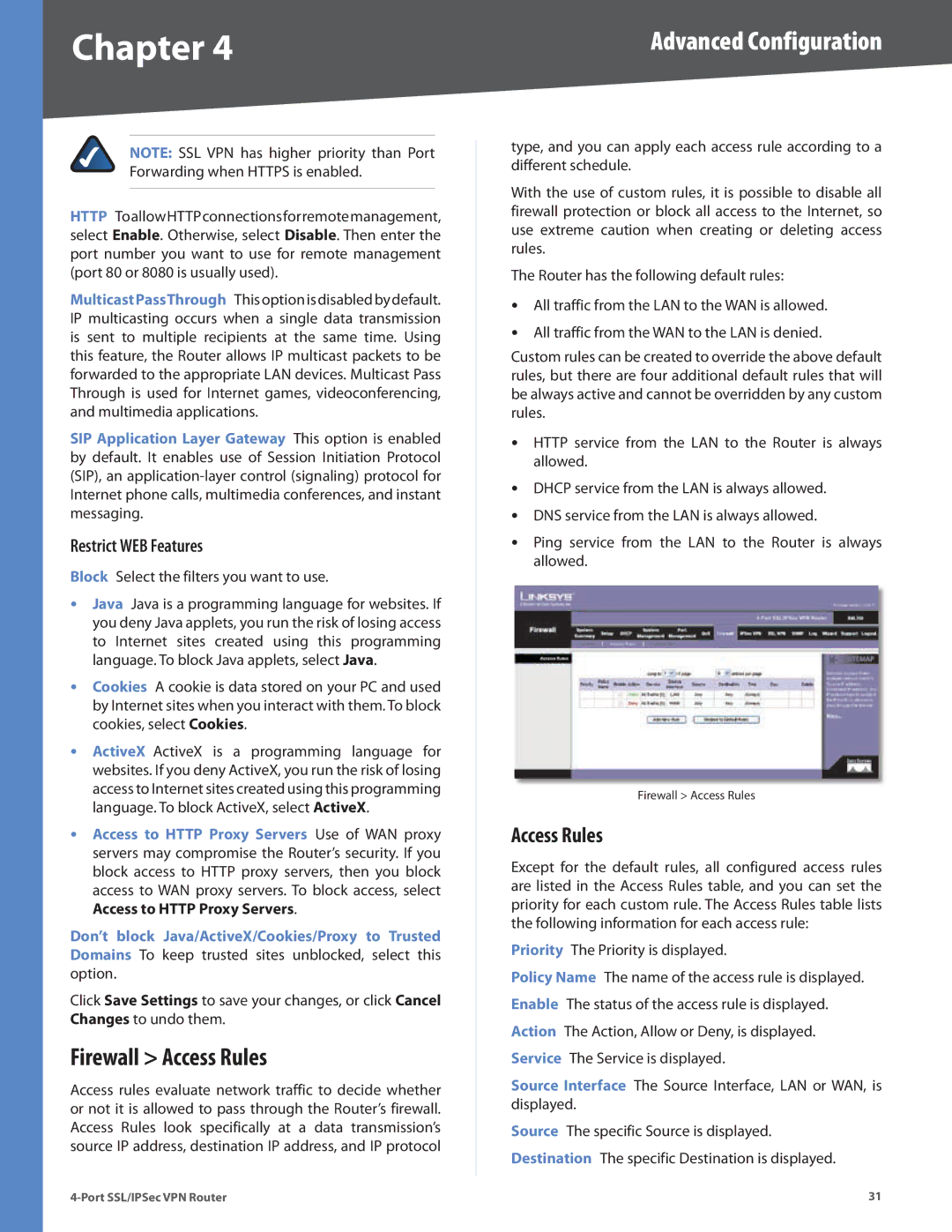
Chapter 4 | Advanced Configuration |
NOTE: SSL VPN has higher priority than Port Forwarding when HTTPS is enabled.
HTTP ToallowHTTPconnectionsforremotemanagement, select Enable. Otherwise, select Disable. Then enter the port number you want to use for remote management (port 80 or 8080 is usually used).
MulticastPassThrough Thisoptionisdisabledbydefault. IP multicasting occurs when a single data transmission is sent to multiple recipients at the same time. Using this feature, the Router allows IP multicast packets to be forwarded to the appropriate LAN devices. Multicast Pass Through is used for Internet games, videoconferencing, and multimedia applications.
SIP Application Layer Gateway This option is enabled by default. It enables use of Session Initiation Protocol (SIP), an
Restrict WEB Features
Block Select the filters you want to use.
•Java Java is a programming language for websites. If you deny Java applets, you run the risk of losing access to Internet sites created using this programming language. To block Java applets, select Java.
•Cookies A cookie is data stored on your PC and used by Internet sites when you interact with them. To block cookies, select Cookies.
•ActiveX ActiveX is a programming language for websites. If you deny ActiveX, you run the risk of losing access to Internet sites created using this programming language. To block ActiveX, select ActiveX.
•Access to HTTP Proxy Servers Use of WAN proxy servers may compromise the Router’s security. If you block access to HTTP proxy servers, then you block access to WAN proxy servers. To block access, select Access to HTTP Proxy Servers.
Don’t block Java/ActiveX/Cookies/Proxy to Trusted Domains To keep trusted sites unblocked, select this option.
Click Save Settings to save your changes, or click Cancel Changes to undo them.
Firewall > Access Rules
Access rules evaluate network traffic to decide whether or not it is allowed to pass through the Router’s firewall. Access Rules look specifically at a data transmission’s source IP address, destination IP address, and IP protocol
type, and you can apply each access rule according to a different schedule.
With the use of custom rules, it is possible to disable all firewall protection or block all access to the Internet, so use extreme caution when creating or deleting access rules.
The Router has the following default rules:
•All traffic from the LAN to the WAN is allowed.
•All traffic from the WAN to the LAN is denied.
Custom rules can be created to override the above default rules, but there are four additional default rules that will be always active and cannot be overridden by any custom rules.
•HTTP service from the LAN to the Router is always allowed.
•DHCP service from the LAN is always allowed.
•DNS service from the LAN is always allowed.
•Ping service from the LAN to the Router is always allowed.
Firewall > Access Rules
Access Rules
Except for the default rules, all configured access rules are listed in the Access Rules table, and you can set the priority for each custom rule. The Access Rules table lists the following information for each access rule:
Priority The Priority is displayed.
Policy Name The name of the access rule is displayed. Enable The status of the access rule is displayed. Action The Action, Allow or Deny, is displayed. Service The Service is displayed.
Source Interface The Source Interface, LAN or WAN, is displayed.
Source The specific Source is displayed. Destination The specific Destination is displayed.
31 |
